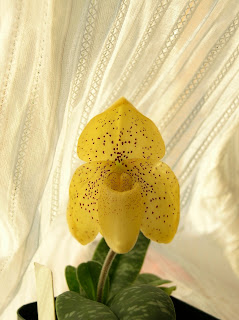 |
| Paph. concolor v. chlorophyllum 'Buttercup' |
Responding to an OGD post regarding a request for Paph concolor photos, I dug up what I had to share. This is a photo of a plant formerly in my collection.
Yes, sadly, formerly. I lost it when I ended up with a resistant, rampant mealybug infestation in a stand of paphs. I finally destroyed them rather than continuing to spray, as the best I was able to do was keep it in check. It was a liability. So after a couple years of fighting it and keeping the plants isolated, I decided that rather than risk sharing such pests with anyone who got plants from me, I should put everyone who was infected into a black plastic bag. It still makes me ill to think about it. I had several very nice things in there.
This, kids, is why some people quarantine newcomers. I didn't, and I paid for it.
But back to the plant. Paph concolor is a lovely species, with butter yellow flowers and lovely, thick, crystalline tessellated foliage. It and things like it really love calcium, and I always thought my success with them was a result of having hard water. (See? There is an up-side to hard water.)
The irony of this situation is that this flower smells like pesticide. Not everyone can pick it up, its faint, and also, easy to mistake for pesticide residue. However, this plant bloomed *before* the major infestation began, and so nothing else was stinky at the time.
I maintain that a lot of plants have some fragrance and we never hear about it. People are convinced "Paphiopedilums have no fragrance", so they never check. But I have come across several that are. So don't feel silly, sniff every flower to see if you can detect something that someone else missed.
